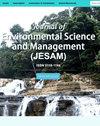Climate Variability, Change and the Impacts on Livelihood Vulnerability of Farming Households in Koronadal, South Cotabato, Philippines
IF 0.3
4区 环境科学与生态学
Q4 ENVIRONMENTAL SCIENCES
Journal of Environmental Science and Management
Pub Date : 2020-12-30
DOI:10.47125/jesam/2020_sp2/04
引用次数: 1
Abstract
This study examined the changes and variability in temperature and rainfall patterns in the past 31 years (1981-2012) and assessed their impacts on livelihood vulnerability of farming households in the City of Koronadal, South Cotabato, a less studied area in Mindanao located in Southern Philippines. Using the Intergovernmental Panel on Climate Change (IPCC) framework, household vulnerability was assessed using survey data from 265 respondents, complemented with focus group discussion, and field observations from 2013 to 2015. Results showed significant changes in monthly mean minimum (increased by 0.74 C, p <0.01) and mean maximum (decreased by 0.65C, p <0.01) temperature. Rainfall patterns showed a decreasing trend and revealed significant changes in June (p<0.01), August, and December (p<0.05), signifying that climate change and variability took place as manifested by floods, landslides, and drought experienced by farming households. The study confirmed that majority of the farming households had “moderate to high vulnerability” to climate variability and change. As climate change brings new forms of risks, appropriate adaptation strategies are needed to address both current and future vulnerability and require robust vulnerability assessment founded on recent scientific advancement and innovative strategies congruent to this study.气候变率、变化及其对菲律宾南哥打巴托市Koronadal农户生计脆弱性的影响
本研究考察了过去31年(1981-2012年)温度和降雨模式的变化和变率,并评估了其对菲律宾南部棉兰老岛研究较少的南哥打巴托市科罗那达尔市农户生计脆弱性的影响。利用政府间气候变化专门委员会(IPCC)框架,利用265名受访者的调查数据,辅以焦点小组讨论和2013年至2015年的实地观察,对家庭脆弱性进行了评估。结果:月平均最低气温上升0.74℃,p <0.01;月平均最高气温下降0.65℃,p <0.01;6月(p<0.01)、8月(p<0.05)和12月(p<0.05)降水模式呈减少趋势,且变化显著,表明气候变化和变率主要表现为农户经历的洪水、滑坡和干旱。该研究证实,大多数农户对气候变率和变化具有“中等到高度的脆弱性”。由于气候变化带来了新的风险形式,需要适当的适应战略来应对当前和未来的脆弱性,并需要基于最新科学进展和与本研究一致的创新战略进行强有力的脆弱性评估。
本文章由计算机程序翻译,如有差异,请以英文原文为准。
求助全文
约1分钟内获得全文
求助全文
来源期刊

Journal of Environmental Science and Management
ENVIRONMENTAL SCIENCES-
CiteScore
0.90
自引率
0.00%
发文量
10
审稿时长
2 months
期刊介绍:
The Journal of Environmental Science and Management (JESAM) is an international scientific journal produced semi-annually by the University of the Philippines Los Baños (UPLB).
JESAM gives particular premium to manuscript submissions that employ integrated methods resulting to analyses that provide new insights in environmental science, particularly in the areas of:
environmental planning and management;
protected areas development, planning, and management;
community-based resources management;
environmental chemistry and toxicology;
environmental restoration;
social theory and environment; and
environmental security and management.
 求助内容:
求助内容: 应助结果提醒方式:
应助结果提醒方式:


